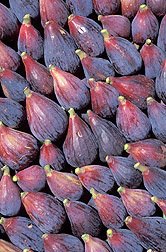 Last summer, as I was enjoying reading the Aug/Sept issue of that marvelous foodie magazine Saveur, in an article about some charming woman in Nîmes who loves to cook, she talked about making fig jam. As our fig tree was producing more sweet black Mission figs than we could keep up with eating, I thought, what a great idea. So I gave it a try, and it turned out to be easy and delicious.
Last summer, as I was enjoying reading the Aug/Sept issue of that marvelous foodie magazine Saveur, in an article about some charming woman in Nîmes who loves to cook, she talked about making fig jam. As our fig tree was producing more sweet black Mission figs than we could keep up with eating, I thought, what a great idea. So I gave it a try, and it turned out to be easy and delicious.In the process, I also learned a new word: macerate. Unenlightened about maceration, I was initially skeptical of the recipe that called for equal weights of chopped figs and sugar, plus a few lemon slices, to just let it sit in a heap for a couple of hours and then boil it. Boil it? I doubted. Surely one needed some liquid. I had made kumquat marmalade before, and that recipe called for liquid ingredients. But I figured I'd give it a go with a small batch. I sliced up a dozen figs, sliced up a half lemon, poured on some sugar, and let it sit in the pot. Two hours later, I understood maceration. Macerating is like marinating, only in reverse. The sugar draws the liquid out of the fruit. After a couple of hours, I had a chunky fig sludge that looked (and was) much more conducive to boiling. Then, just 12-14 minutes of boiling over medium-low heat, and there was fig jam! Just pour it into sterilized jam jars (prepared in the usual way by boiling the jars) and voilá. That charming French woman was right. (She was also right about the fact that fig jam makes a delectable complement atop a good vanilla ice cream. My first test batch filled one jam jar with just enough left over to put on some ice cream.)
Well, now it's fig time again, and the kitchen counter is filled with figs. I made a batch of jam a couple nights ago, but the counter is filled again, so I'll probably make some more. Just a few recipe notes:
- She just quarters her figs, but I found that while the fig innards completely dissolve, the skins don't, so I've chopped them up a bit smaller than quarters (but still nothing close to mincing).
- Last time I just used the lemon juice and pulp rather than putting in entire lemon slices.
- This time I used a dozen medium to large figs plus half a lemon and got a couple small jam jars out of it.
- Her recipe calls for equal weights of fig and sugar. These Europeans seem to weigh everything rather than measure volume. Do they all have little scales in their kitchens? In any event, I just eyeballed it. Put the figs in the pan and poured enough sugar over them to thickly coat them and it looked "even". (I suppose being American, I'm still thinking of volume even when I eyeball it. Equal volume is probably proximate to equal weight, no? How, I wonder, do figs and sugar compare in density?)
- Stir frequently as it gets hot (and mash up the thick bits), and after a dozen or so minutes, the fruit is dissolved and you'll have a dark sweet-smelling syrup. (The recipe called for a temp of 215, but I went by time and eyeballing.)
- The USDA says: "Figs are high in fiber and are a good source of several essential minerals including magnesium, calcium, and potassium."
- Enjoy! (And don't forget to put the leftovers on some ice cream or yogurt - or just lick the pan!)

No comments:
Post a Comment